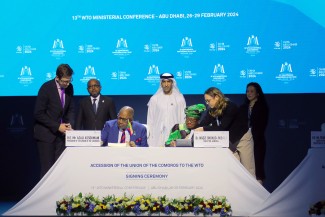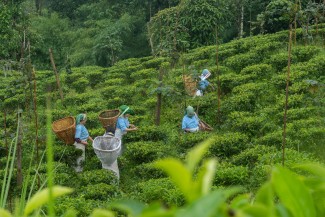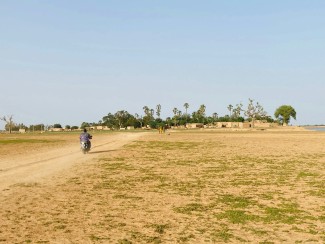Making more and better ginger crops means more income
The low-lying plains of the Morang district in southeastern Nepal should be the perfect place for growing ginger. The weather is warm, the soil moist.
And yet farmers there have been routinely losing up to 90 per cent of their ginger crops.
Parbati Magar was one of the farmers who witnessed her entire ginger crop wither and die, season after season, from a disease called rhizome rot.
"I had no knowledge of [how to treat] this problem,” she said. Neither did the extension workers visiting her village. So Parbati decided to quit farming and found a job in a nearby village to make enough money to provide for her five children.
Indeed, many of Nepal’s ginger producing regions saw farmers shifting to different businesses or reducing their ginger cultivation in response to such post-harvest loss problems. Those who continued to cultivate some ginger were selling it at low prices to intermediaries due to the fact that it was poor quality and covered in dirt.
“Small-scale ginger farmers, many of them women with few other income-generating opportunities, were disconnected from markets, and unable to meet international standards and benefit from opportunities to increase their incomes though trade,” said Marlynne Hopper, Deputy Head of the Standards and Trade Development Facility (STDF).
The STDF, in partnership with the Enhanced Integrated Framework (EIF) and the UN Food and Agriculture Organization, saw an opportunity to support and grow Nepal’s ginger industry.
Quality and quantity
One of the first things they chose to do was to equip farmers with the skills, knowledge and confidence to produce higher quality and quantities of ginger.
They followed the farmer field school approach, training 59 lead farmers across eastern Nepal to manage pests and diseases, care for seeds, handle and store ginger after harvesting, and keep accurate records. These farmer facilitators then mentored other farmers in their district to apply the newly learnt skills and knowledge, using drama, video and visual aids to get messages across in communities with low literacy levels. Farmers were also supplied with improved planting materials.
When she heard about the farmer field school coming to her village, Parbati was sceptical at first, as she didn’t see how it would help fix her rhizome rot problem. She decided to participate in the training, joining a group experimenting with new methods and techniques to manage rhizome rot in a demonstration plot.
"[After treating the ginger seeds], the problem was not severe as before,” she said. Equipped with the knowledge, skills and networks she needs to succeed, Parbati has decided to try cultivating ginger again.
In neighbouring Jhapa district, farmer facilitator Mahesh Timsina saw farmers also overcome similar challenges that had previously led them to abandon ginger farming.
“Previously known ginger pockets in Jhapa have again revived ginger production,” he said.
Using the farmer field school approach, nearly 2,000 farmers were trained (60 per cent of them women), and losses of ginger after harvest across the field sites in eastern Nepal decreased by 30 per cent.
First of its kind
The next challenge to be tackled was the low quality of ginger being exported, leading to lower prices for Nepali ginger on the world market.
Nepal is the fourth largest producer of ginger worldwide and the sixth largest exporter. Ginger represents the country's most important spice export, with exports in 2008 worth US$8.2 million.
However, farmers were unable to access higher-value markets in the region and beyond, given their inability to meet international standards recognized under the World Trade Organization’s (WTO) Agreement on the Application of Sanitary and Phytosanitary Measures, which sets out the basic rules for food safety and animal and plant health standards.
Working together with the Nepal Ginger Producers and Traders Association (NGTPA) and several government ministries, a ginger washing facility – the first of its kind – was built, with capacity to wash 18 metric tons of export quality ginger per hour.
“The washing facility is a milestone in our export development… it’s enabled us to increase ginger exports by 20-30 per cent,” said NGPTA secretary Hemanta Bohora.
Along with the increased exports has come new buyers.
Hopper said, "The washing facility along with improvements in ginger production and post-harvest handling at the farm level, and increased sanitary and phytosanitary measures [SPS] and capacity of government authorities, has opened up access to new markets. In 2018, Nepalese ginger was exported to Bangladesh and Europe.”
Finding a path forward
Due to these increases in ginger productivity, reduced costs of cultivation and export quality, farmer income has increased by 62 per cent.
Most farmer field schools are still in operation, with demonstration plots becoming seed resource centres and providing higher-quality planting materials. Extension agents supporting farmers like Parbati are up-to-date with the latest information and are utilizing training materials to reach even more farmers.
Perhaps most importantly, it’s taught Nepali ginger farmers how to be resilient in times of crisis.
EIF Executive Director Ratnakar Adhikari said, “This project shows that practical, country-owned initiatives like this can produce significant pay-off in terms of poverty reduction and is worth replicating in other parts of the country. Scaling up training on good agriculture practices to cover all ginger farmers and providing them with quality seeds are critical to enhance productivity as well as enhance quality of ginger.”
Said Ganesh Pokharel, a farmer-facilitator from Panchthar district, “Ultimately, it has opened our eyes and placed new innovations in our hands. It has taught us the art to finding a path when in crisis that we can apply in the future as well.”
If you would like to reuse any material published here, please let us know by sending an email to EIF Communications: eifcommunications@wto.org.



